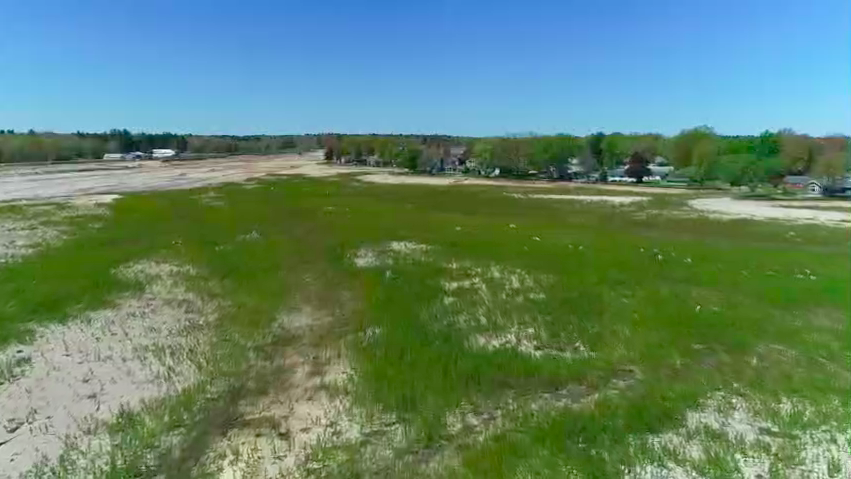SANFORD, Mich. (WXYZ) — A year ago this week, Dolores Porte could only watch as her small lakefront village of Sanford was swallowed whole.
“The darkest day was to come down here and to see only the rooftops of these businesses,” Porte said. “And to know that everything inside was destroyed and to know that peoples’ houses were washed away.”
One year ago, the small waterfront community where Porte is village president was underwater after the Sanford and Edenville Dams both gave way, and hell broke loose.
Some 150 homes were destroyed and more than 800 were badly damaged. Small businesses that had always been here suddenly weren’t.
“When all this happened, all our lived changed at once, all in the same way,” said Connie Methner, owner of CJ’s Hairstyling . “We all lost something.”

A year ago, Ray Bauers’ home was unlivable. Today, we found him moved back in after rebuilding his house from the inside out.
“People started coming around, volunteers, all the churches,” Bauers said. “It was just unbelievable, the people.”
He was hit twice: not only was Bauers' home devastated by the floods, but his auto sales business downtown was crippled.
Today, half of it has been demolished and, after repairing his home, his new mission is to bring his business back to life.
“The good Lord says you can only handle what I’ll put on your shoulders,” Bauers said. “Well, evidently I got big shoulders.”
Down the street from Bauers’ store, Sanford Hardware just reopened last week. The original store was demolished after the floods tore it in half.
“Did this seem possible?” asked Channel 7’s Ross Jones.
“There was never an impossible. Not even from day one,” said Kathy Sian, who owns the store with her husband Denny.
“When we came down to look at our damage, we were followed by friends, members of our community,” she said, fighting back tears. “They just lifted us up and so, before we arrived, we acknowledged the fact that God was in charge of it and not us.”
Social media played a big role, too. The Facebook group “Sanford Strong” was started the day the dams broke, with people offering everything from donated furniture to meals, help digging out, and building back up.
Fewer than 900 people live in this town. Today, the group stands at more than 12,000.
“Everybody helped everybody,” Methner said. “Everybody had a smile on their face for everybody. This town has changed!”
To be clear, rebuilding has cost almost everyone a small fortune. Virtually no one affected had flood insurance because their homes and businesses weren’t in a flood zone. But the generosity of strangers has made getting even this far even possible.
“We have over $4.5 million donated from the community, from churches,” said Anne Wortley, a disaster case manager with the United Methodist Committee on Relief.
So far, she’s helped 26 families rebuild their old homes or find a new one and knows she’s not even close to finished.
While it’s tempting to focus on just the progress that’s been made in the last year, it’s only half the story.
Last week, Dolores Porte toured an empty field not from where the Sanford Dam failed. A year ago, it was the site of 12 homes that were carried away by the floods.
“Right after it took place, you saw tops of homes, decks from homes, people’s sheds, all their belongings hanging from trees stuck in the mud,” she said. “It was horrifying here.”
Now, the town is planning to turn the former neighborhood into a park, complete with a plaque to memorialize the homes that were lost.
For those trying to rebuild, costs are through the roof. The nationwide lumber shortage makes the cost of building a home, on average, $36,000 more than a year ago, wiping out many of the FEMA payments some residents received.
“It’s really stretched our resources,” said Teresa Quintana, an organizer with the Facebook group Sanford Strong. “I’m really hoping that our representatives are going to be actively doing something about that.”
And then there are the lakes. Secord, Smallwood, Wixom and Sanford Lakes never returned following the dam failures. Poplar trees continue to grow where there was once water, and pontoon boats that the floods tossed around still lie near the road.
Nobody claimed them. With no water for miles, what’s the point?

If the lakes ever do return, residents will have to help pay for them. The Four Lakes Task Force, which recently purchased the dams from owner Boyce Hydro, says restoring lake levels will come at a cost to property owners, assessed a few thousand dollars every year for the next 40 years.
The Four Lakes Task Force estimates that lakes will be returned by 2026.
Janis Colton has lived here since 1976. While the task force says they’re pursuing state and federal grants to bring the cost down, she says any cost is too much to bear.
“You can’t bleed a stone, and that’s what they’re trying to do,” Colton said. “They want to take money from people who don’t have it in order to create this dam that we don’t own.”
There’s no telling where this town will be a year from now. But one year ago, few would have thought they’d make it here.
At Connie Methner’s hair salon—rebuilt with help from the community — you’ll find photos of last year’s devastation dotting the walls. A reminder of what it took to get here, not that anybody needs it.
“No matter how much money you have. No matter the size of house … we all went under, and it’s not a nice place to be,” she said. “I think we’re a better town now.”
Contact 7 Investigator Ross Jones at ross.jones@wxyz.com or at (248) 827-9466.


